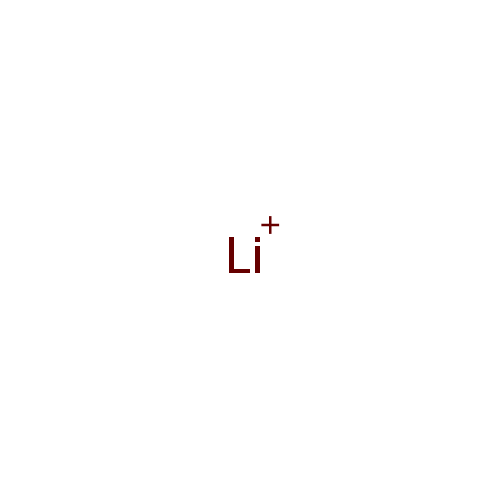|
Record Information |
|---|
| Version |
1.0 |
|---|
| Update Date |
1/22/2018 11:54:54 AM |
|---|
|
Metabolite ID | PAMDB001788 |
|---|
|
Identification |
|---|
| Name: |
Lithium |
|---|
| Description: | Lithium (Li) is an alkali metal with atomic number 3. Trace amounts of lithium are present in all organisms, though the element serves no apparent vital biological function. (Wikipedia) Scientific research has suggested that lithium is an inhibitor of several Pseudomonas aeruginosa enzymes, such as L-rhamnulose-1-phosphate aldolase. (EcoCyc) |
|---|
|
Structure |
|
|---|
| Synonyms: | - Li
- Li(+)
- Li(+) cation
- Li(+) ion
- Lithium atom
- Lithium cation
- Lithium element
- LITHIUM ION
- Lithium(+)
- Lithium, ion
- Lithium, ion (Li1+)
|
|---|
|
Chemical Formula: |
Li |
|---|
| Average Molecular Weight: |
6.941 |
|---|
| Monoisotopic Molecular
Weight: |
7.016004049 |
|---|
| InChI Key: |
HBBGRARXTFLTSG-UHFFFAOYSA-N |
|---|
| InChI: | InChI=1S/Li/q+1 |
|---|
| CAS
number: |
7439-93-2 |
|---|
| IUPAC Name: | lithium(1+) ion |
|---|
|
Traditional IUPAC Name: |
lithium(1+) ion |
|---|
| SMILES: | [Li+] |
|---|
|
Chemical Taxonomy |
|---|
|
Taxonomy Description | This compound belongs to the class of inorganic compounds known as homogeneous alkali metal compounds. These are inorganic compounds containing only metal atoms,with the largest atom being a alkali metal atom. |
|---|
|
Kingdom |
Inorganic compounds |
|---|
| Super Class | Homogeneous metal compounds |
|---|
|
Class |
Homogeneous alkali metal compounds |
|---|
| Sub Class | Not Available |
|---|
|
Direct Parent |
Homogeneous alkali metal compounds |
|---|
| Alternative Parents |
Not Available |
|---|
| Substituents |
- Homogeneous alkali metal
- Acyclic compound
|
|---|
| Molecular Framework |
Acyclic compounds |
|---|
| External Descriptors |
|
|---|
|
Physical Properties |
|---|
| State: |
Solid |
|---|
| Charge: | 1 |
|---|
|
Melting point: |
190 °C |
|---|
| Experimental Properties: |
|
|---|
| Predicted Properties |
|
|---|
|
Biological Properties |
|---|
| Cellular Locations: |
Cytoplasm |
|---|
| Reactions: | |
|---|
|
Pathways: |
|
|---|
|
Spectra |
|---|
| Spectra: |
|
|---|
|
References |
|---|
| References: |
- Aghdam SY, Barger SW: Glycogen synthase kinase-3 in neurodegeneration and neuroprotection: lessons from lithium. Curr Alzheimer Res. 2007 Feb;4(1):21-31. Pubmed: 17316163
- Kofman O, Belmaker RH: Ziskind-Somerfeld Research Award 1993. Biochemical, behavioral, and clinical studies of the role of inositol in lithium treatment and depression. Biol Psychiatry. 1993 Dec 15;34(12):839-52. Pubmed: 8110911
- Quiroz JA, Machado-Vieira R, Zarate CA Jr, Manji HK: Novel insights into lithium's mechanism of action: neurotrophic and neuroprotective effects. Neuropsychobiology. 2010;62(1):50-60. doi: 10.1159/000314310. Epub 2010 May 7. Pubmed: 20453535
- Waring WS: Management of lithium toxicity. Toxicol Rev. 2006;25(4):221-30. Pubmed: 17288494
- Zhong J, Lee WH: Lithium: a novel treatment for Alzheimer's disease? Expert Opin Drug Saf. 2007 Jul;6(4):375-83. Pubmed: 17688381
|
|---|
| Synthesis Reference: |
Not Available |
|---|
| Material Safety Data Sheet (MSDS) |
Download (PDF) |
|---|
|
Links |
|---|
| External Links: |
|
|---|


